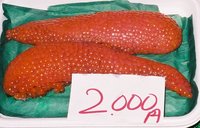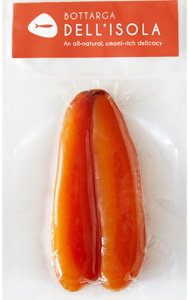What is Roe and Caviar?

Salmon roe at the Shiogama seafood market in Japan
Roe is the fully ripe egg masses of fish and certain marine invertebrates, such as sea urchins.
As a seafood it is used both as a cooked ingredient in many dishes and as a raw ingredient.
A variety of roe types is used in Japanese cuisine, including the following which are used raw in sushi:
- Ikura - Salmon roe. Large reddish-orange individual spheres. Since salmon eggs are also used as bait, first-time sushi eaters who have experience fishing may be intimidated.
- Kazunoko - Herring roe, pinkish yellow, usually pickled. The roe is in a single cohesive mass and so looks like a piece of fish.
- Masago - small eggs of the Capelin, slightly orange in color
- Tobiko - Flying-fish roe, very crunchy. Similar in appearance to Masago, but more red.
- Uni - sea urchin roe, soft and melting. Color is an indication of quality and can range from orange to pale yellow.
Lumpfish (stenbider) roe is used extensively in Danish cuisine, on top of halved or slicd hard-boiled eggs, on top of mounds of shrimp, or in combination with other fish or seafood. Another commonly eaten roe is that from the cod (torsk).
Taramasalata is a well-known Greek dish consisting of roe pureed with some boiled potatoes.
What is the difference between Roe and Caviar?
Caviar is the processed, salted roe of various species of fish, most notably sturgeon. It is commercially marketed throughout the world as a delicacy and is eaten principally as a garnish or spread, as with hors d'oeuvres.
In the United States and Canada, any product that is only labeled caviar must come from sturgeon roe.
Today the best caviar comes from sturgeon fished from the Caspian Sea by Iranian and Russian fishermen. Some of the highest prices are paid for Beluga, Ossetra, and Sevruga varieties (note that the large-grained Beluga caviar comes from the Beluga sturgeon and has nothing to do with the Beluga whale). Dwindling yields due to overfishing and pollution have resulted in less costly alternatives, processed from the roe of whitefish and North Atlantic salmon, becoming popular.
In the United States, several kinds of roe are produced: salmon from the Pacific coast, shad and herring species like the American shad and alewife, mullet, paddlefish, American bowfin, and some species of sturgeon. Shad, pike and other roe are sometimes pan-fried with bacon. Spot Prawn roe (hard to find) is also a delicacy from the North Pacific. Flounder roe, pan-fried and served with grits is popular on the Southeastern coast.
"..In Russian, all types of fish roe are called "икра" (ikra, caviar), and there is no linguistic distinction between the English words "roe" and "caviar." Sturgeon roe, called "чёрная икра" (chyornaya ikra, "black caviar") is most prized. It is usually served lightly salted on buttered wheat or rye bread, or used as an ingredient in various haute cuisine sauces and dishes. It is followed in prestige by salmon roe, called "red caviar," which is less expensive, but still considered a delicacy..." see wikipedia
Bottarga

Bottarga is the roe sac of a fish, most commonly grey mullet, which is salted, and then pressed and dried.
Culinary Use
Its culinary properties may be compared to those of dry anchovies, although it is much more expensive. Often, it is served with olive oil or lemon juice as an appetizer accompanied by bread or crostini. It is also used in pasta dishes. It can be grated much like parmesean cheese or sliced thin.
Nutritional Value of Caviar (Roe)
A spoonful of caviar supplies the adult daily requirement of vitamin B12, it is also high in cholesterol and salt. 1 tablespoon (16 g) of caviar contains:
- Energy: 42 calories
- Fat: 2.86 g
- Carbohydrates: 0.64 g
- Fibers: 0 g
- Protein: 3.94 g
- Sodium: 240 mg
- Cholesterol: 94 mg
- Zinc: 12.18 mg
Health Benefits of Salmon Roe
While Alaska salmon is known for its high level of heart healthy omega-3 fatty acids and lean protein, the omega-3 and protein content found in the roe far exceeds that of the meat. In addition, important vitamins and minerals are abundant in Alaska salmon roe.-- source --Alaska Salmon Roe: Nutritional Information